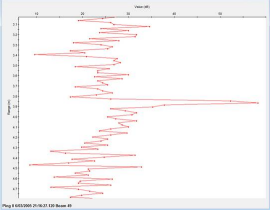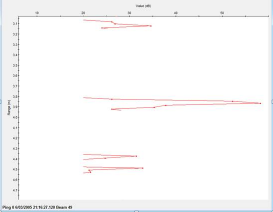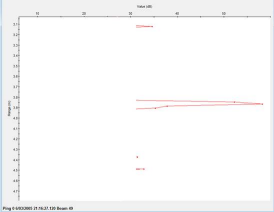Double Threshold
This operator applies a double threshold filter to multibeam variables for the purpose of removing data (e.g. noise) within a specified range.
It applies two thresholds to the data as follows:
- Values that are equal to or above the upper threshold are unchanged.
- Values that are equal to or below the lower threshold are set to a specified threshold value.
- Values that are between the two thresholds and within the specified influence radius from a data point that has been unchanged are unchanged.
- Values that are between the two thresholds yet outside the specified influence radius are set to a specified threshold value.
You enter the threshold settings on the Double threshold page of the Variable Properties dialog box.
Echoview accepts a single operand of the following data types as input:
- Multibeam magnitude
- Multibeam Sv
- Multibeam TS
- Multibeam unspecified dB
Settings
The Double Threshold Variable Properties dialog box pages include (common) Variable Properties pages and these operator pages:
Operands page
Double Threshold page
|
Settings |
Description |
|
Lower threshold |
Specifies the lowest data value for the criteria applied in the double threshold algorithm. |
|
Upper threshold |
Specifies the highest data value for the criteria applied in the double threshold algorithm. |
|
Influence radius |
Specifies the radius for the area of influence around particular samples. The Influence radius is used for the criteria applied in the double threshold algorithm. |
|
Set thresholded values to |
Specifies a single value that is applied to all samples that need to be changed, when the double threshold algorithm is applied. |
Note: The performance of this operator degrades linearly with increasing difference between the two thresholds and in the square (second order) with Influence radius. This operator completes within 30 seconds on common computer configurations available in August 2004 with a difference in thresholds of 100 units, and Influence radius of 0.3m. It was found to take of the order of 10 minutes with a difference in thresholds of 300 and an Influence radius of 1.00.
Algorithm and example
The Double Threshold works like this:
- All samples with values below the Lower threshold are "thresholded out".
- All samples with values above the Upper threshold are retained.
- For samples with values between the thresholds:
- Values that are between the two thresholds and within the specified Influence radius ("close") from a data point that has been unchanged are unchanged.
- Values that are between the two thresholds yet outside the specified Influence radius are set to a specified threshold value.
"thresholded out" means set to a specified Set threshold value to i.e. 0, -999, etc.
“close” means within a specified Influence radius.
One way of thinking about the Double Threshold operator is that the Lower threshold takes away the noise floor and the Upper threshold takes away the small scatterers, leaving only the big scatterers. The Influence radius allows the strong scatterer's whole pulse to be retained, even though some of its samples are likely to be below the Upper threshold.
|
Figure 1. A portion of an individual DIDSON beam.
|
Figure 2: Effect of a Double Threshold operator. Same beam as in Figure 1 with a Lower threshold of 20, an Upper threshold of 32 and an inclusion radius of 0.1. |
Figure 3: Same beam as Figure 1 with traditional (non-Double) threshold set at 32: the same peaks are retained but their pulse shape information is lost. |


